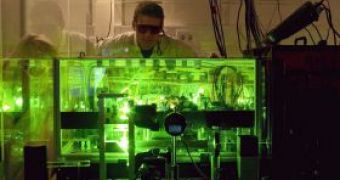The principle behind the newly developed technique involves using light in order to trigger a physical transition without varying the temperature of the material in wide ranges. This is usually done with the help of a coherent light source, such as radiation emitted by lasers, that interacts with a system on a molecular level. This is mostly used in innovative experiments, in the hope that it will give rise to a new type of electronic and optical devices.
Now, the technique opens new possibilities for the creation of ultra-fast optical shutters, for the telecommunication technology using light as a medium to transfer information. Previous experiments, conducted by Richard Haglund of Vanderbit and Alfred Leitenstorfer from Konstanz, on vanadium oxide to test its switching capabilities, involved heating the crystal at temperatures below 68 degrees Celsius, during this time the crystal film remaining a transparent semiconductor. As temperature was being risen just a few degrees over the critical level, the transparent film changed its optical properties and became opaque-reflective, similar to the surface of a metal.
The effect can only be explained by changes in the crystalline properties of the film. Possible applications for this material involve the so-called 'thermochromic window' that would have the capability of changing its optical properties, when subjected to various temperatures.
However, Haglund and Rene Lopez thought they could do better, so in 2005, they tested the action of an ultra-fast laser on the vanadium dioxide crystal in order to see whether they could obtain a similar transition or not. They realized that the 120-femtosecond pulses of the laser were able to shift the vanadium oxide film from transparent to reflective, in less than 100 femtoseconds, meaning the fastest transition phase ever measured.
The experiment quickly captured scientific attention, due to the rapid transition phase it presented, and two years later, they tested the VO2 film with a laser pulsing 12 femtoseconds beams of light, triggering the crystal to shift even faster.
Nevertheless, the mechanisms behind this record breaking transition remained somehow puzzling. In an effort to explain what happened in the VO2 film, Carl Kubler designed a technique in which infrared radiation, coming from the photons as the pulsing laser hit them, was converted into a wide spectrum of infrared wavelengths, which bracket the vanadium dioxide crystal vibration.
At the same time, they realized that the VO2 film was transparent to the infrared radiation and independent of the state in which the crystal was. Laser light does not produce the transition from transparent to opaque by heating the crystal, as everyone would presume, but the photon hitting the oxygen atoms in the crystal lattice does, by changing their positions.
Haglund explains that most people believe that this has something to do with the fact that the electrons are excited by the light beam, and the crystal structure changes. But, as the experiment showed, it changed its coherent molecular vibration, determining a change in structure, which did not need a change in the temperature of the film.

 14 DAY TRIAL //
14 DAY TRIAL //